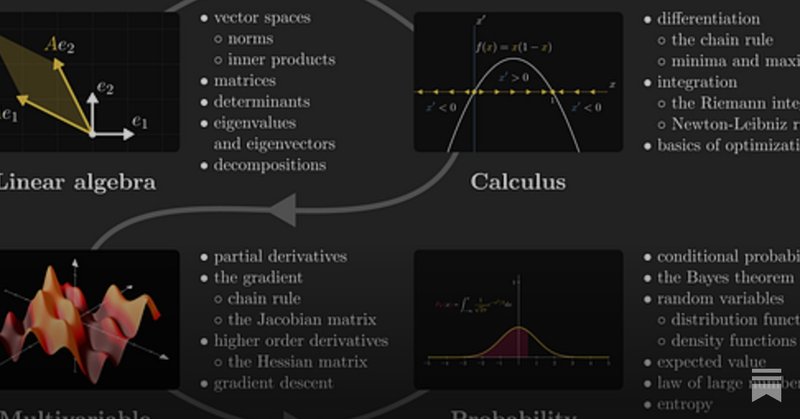
Tivadar Danka
@TivadarDanka
Followers
85K
Following
8K
Media
3K
Statuses
8K
I make math and machine learning accessible to everyone. Mathematician with an INTJ personality. Chaotic good.
Hungary
Joined June 2017
I wrote a 4000-words long article about all the math you need to know for machine learning. Trust me, you want to bookmark this: https://t.co/sV52SBB16J
thepalindrome.org
A complete guide to linear algebra, calculus, and probability theory
15
93
672
Join 33,000+ ML practitioners who get 2 actionable emails every week to help them understand the math behind ML, make smarter decisions, and avoid costly mistakes. Subscribe here (it’s free):
thepalindrome.org
mathematics ∪ machine learning. Click to read The Palindrome, a Substack publication with tens of thousands of subscribers.
1
0
8
The removal of the edge ab produces two connected components.
1
0
7
In the previous graph, the removal of vertex a (and its corresponding edges) produces five connected components, while the removal of vertex b produces two.
1
0
5
An interesting question regarding connectivity is how critical a vertex or edge is regarding connectivity. If removing a single vertex (or edge) from a graph splits a connected component into two or more, then that vertex is called a cut vertex (or cut edge).
1
0
6
So, vertices and edges are the building blocks of graphs, giving rise to walks, trails, and paths. With these notions, we can start to ask general questions about the structure of a graph. One question is connectivity, that is, which vertices are reachable from each other.
1
0
5
Mempool Accelerator™ fixes this Launch of open beta starts today! Click Accelerate from the transaction page and pay with lightning or fiat. No sign up necessary. Initial mining pool partners make up 40% of Bitcoin’s global hashrate: @FoundryServices, @MarathonDH, @SBICrypto,
21
64
307
If we never repeat a vertex, then we have a path. For instance, (c, d, e, a, b) is a path that happens to involve all vertices. However, if the path loops over from the final vertex back into the first one, so the start and end are the same vertex, we call it a cycle.
1
0
4
If we never repeat an edge, then we have a trail. The previous walk is not a trail because we backtrack through ab. In contrast, (a, e, c, d, e) is a valid trail in our example graph, because although e appears twice, we get to it via different edges each time.
1
0
5
In the study of networks, indirect connections are as important as direct ones. Speaking in the language of graphs, indirect connections are formalized by walks. A walk is simply a finite sequence of connected nodes. For example, (a, b, a, e, c, d) is a walk on the graph below.
1
0
7
There is nothing intrinsic to names or the exact locations of the vertices in the drawing. The layout of a graph is arbitrary, and thus, the same graph can be represented in an infinite number of ways.
1
0
6
30-Day Money Back Guarantee If you run a home-service business, this is your chance to try our AI Voice Agent risk-free. Book jobs automatically Follow up with every lead instantly Answer calls 24/7 — never miss a job
0
0
1
Intuitively, a graph is just a (finite) collection of elements — vertices, or sometimes nodes — connected by edges. Thus, a graph represents an abstract relation space, in which the edges define who’s related to whom, whatever the nature of that relation is.
1
0
7
What if we could study this abstract notion of networks of interconnected elements and understand the fundamental properties of all sorts of networks all at once? This is the purpose of graph theory, and we’re here to open a window for you to dive into this universe.
1
0
8
As distinct as these things seem to be, they share common properties. For example, the meaning of “distance” is different for • Social networks • Physical networks • Information networks But in all cases, there is a sense in which some objects are “close” or “far”.
1
1
6
What do the internet, your brain, the entire list of people you’ve ever met, and the city you live in have in common? These are all radically different concepts, but they share a common trait. They are all networks that establish relationships between objects.
1
1
6
Graph theory will seriously enhance your engineering skills. Here's why you must be familiar with graphs:
5
19
131
Most machine learning practitioners don’t understand the math behind their models. That's why I've created a FREE roadmap so you can master the 3 main topics you'll ever need: algebra, calculus, and probabilities. Get the roadmap here:
thepalindrome.org
A complete guide to linear algebra, calculus, and probability theory
0
0
6
There are drawbacks, like the slow convergence, which has a rate of 1/√n, where n is the number of points selected. However, there is no denying it: estimating the area of an object by throwing random points is pretty awesome.
3
0
8
The general method is called "Monte Carlo integration", and as the name suggests, it can be used to evaluate integrals of chunky functions. Even ones with lots of variables.
1
0
7
Combining these two observations, we get that the frequency of hits converges to the ratio of the areas. Thus, we can approximate the area by simply counting the number of hits. This is one of the coolest ideas in mathematics.
1
0
5
On the other hand, the expected value is the probability of a hit. That is, the area of our shape divided by the area of the rectangular board!
1
0
4
On a second look, the average can be written as the total number of hits divided by the total number of points. (Recall that the value of each variable is 0 if it is a miss and 1 if it is a hit.)
1
0
3





